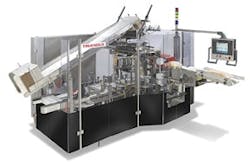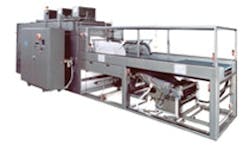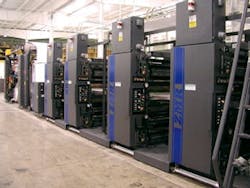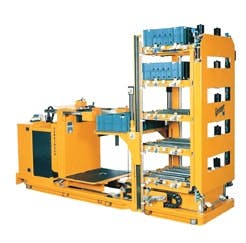Lastly, they tell you a one-hour changeover once every week or two might have been acceptable ion the past, but those days are over. Anything more frequent is simply too costly and would be absolutely ruinous to customer productivity.
That's what they tell you. How do you respond?
Well, it's clear that one of the better ways to increase manufacturing output is to reduce the time required to changeover from one product to another. One of the main tools industrial OEM machine, skid, and robot builders can use to reduce changeover time is automation.
New Environment, New Rules
In this new operating environment, quick changeover from one product to the next is an absolute necessity, and an unbending requirement of industrial OEM customers. "Printers need to cut makeready,the transitioning from one print job to another,because it represents a big percentage of the time it takes to produce a product," says Frank Andaloro, president of E.R. Smith. E.R. Smith is a system integrator specializing in remanufactured printing machinery. "The printing industry is looking for fast makeready and short runs. A long run of 50,000 signatures, the term for packets of pages, could take 15 minutes to makeready, which is acceptable. But when that is broken into 10 runs of 5,000, that's 10 makereadys, each still 15 minutes long, so makeready becomes a huge factor relative to total job cost."
Automation suppliers are seeing the same flexibility requirements being demanded of other machine builders. "Production runs are becoming shorter and the ability to quickly changeover from one package size to another is becoming more important as packagers target smaller niche markets with higher margins," observes Mike Nager, industry marketing manager for Phoenix Contact (www.phoenixcon.com).
Many industries have similar quick changeover needs, and this is driving machine builders to incorporate high levels of automation into their designs.
At Your Servo
A key technique to reduce changeover time involves replacing line-shaft-driven machines with multiple servo motors. ATR of Altoona, Pa., remanufactures envelope-producing machinery, and a recent project replaced a single motor drive/line shaft with 12 synchronized servo motors. This eliminated about a dozen line-shaft connections, five gearboxes and two Positive Infinity Variable (PIV) drives.
"A changeover from one product to another often required maintenance to physically change a half dozen gears to a different tooth count," recalls Marty Karduck, general manager of ATR. "This procedure would typically take about two or three hours.
The servo motors and the automation systems eliminated manual gear changes and now allow operators to change from one product to the next through a recipe manager. The recipe manager transfers product recipe settings to establish the gearing relationship within the machine.
According to Karduck, the norm in the industry has been to physically change gears to make a product change. "So, to assist the operator, the new HMI screens are configured so maintenance personnel can 'pick the gear' that they normally would have installed in the old electromechanical system," adds Karduck.
PIV adjustment required the machine to be running and, therefore, producing scrap during a tuning and setup phase. "The automation and servo system eliminates the PIVs and the setup phase and provides major advantages for end users that require frequent product changeovers," concludes Karduck.
System integrator JL Souser (www.jlsouser.com), York, Pa., worked with ATR on the project, and president Craig Souser explains the control system architecture. "Operator interface is through a Rockwell RSView HMI (http://www.rockwellautomation.com) linked to a ControlLogix PLC and a Bosch Rexroth (http://www.boschrexroth-us.com) motion controller. The Bosch controller is linked to the 12 servos via a SERCOS fiberoptic communications bus."
JL Souser specializes in printing machinery automation, and newer versions of its printer controls incorporate a single Bosch Rexroth controller for both logic and motion. "Our preferred control engine is a Bosch Rexroth PPC because it can handle 32 axis in tight synchronization," adds Souser.
Triangle Package Machinery (http://www.trianglepackage.com) is a Chicago-based OEM of packaging machinery and equipment. Its newest machine, the Triangle/FlexCell, is a bag-in-box cartoner designed to run 90-100 cartons/min. with minimal changeover time and a small footprint (Figure 1).
Figure 1: Quick Change Cartoner
To meet customer requirements for a bag-in-box cartoner that
could run 90-100 cartons/min., the machine was designed with
minimal changeover time as servos replaced manual adjustments
made with handles and indicating scales. Optional components
can be programmed to stay out of the way if not needed for a
particular product. Source: Triangle
In the FlexCell machine, servos were used to replace manual adjustments made with handles and indicating scales. "Linear or rotary servo actuators with absolute position feedback automatically put everything in the correct position every time," says Steve Bergholt, Triangle's chief engineer. "Our customers simply select a recipe at the RSView HMI, and the ControlLogix motion and logic controller moves everything into position over a fiberoptic SERCOS interface. All speed and timing functions for the servos are stored in a recipe for the next product, so interrelated motions all can be set by one master controller."
Different products have different home offsets and startup conditions or positions. Triangle offers optional components that can be programmed to stay out of the way if not needed for a particular product. The integrated HMI, controller, and servo control system architecture allows the machine to change from one size or pack pattern to the next in 10-20 min. The old manual changes required up to four hours.
Another industrial OEM uses a similar control system architecture for one of its packaging machines. KHS Kisters (http://www.kkusa.com), Edgewater, Fla., produces a shrink wrapper that can accommodate a variety of package sizes with an HMI connected to servos via a logic and motion control processor (Figure 2).
Figure 2: Ready for Anything
KHS Kisters worked for nearly two years to design and build
a film wrapper,capable of packaging a variety of bottles in both
a full box and tray,with markedly decreased changeover time.
Source: KHS Kisters
KHS Kisters worked with Rockwell Automation for nearly two years to design and build a machine that met its end user's stringent demands. The resultant control platform drives a robotic partition former and inserter, a box erector, a product group loading section, and a compression section with continuous motion at a rate of 70 cases/min.
Machine production requirements vary widely,the machine had to be capable of packaging six 64-ounce bottles and twelve 46-ounce bottles in both a full box and tray. A key to quick changeover was decreasing the time required for machine operators to make changes to the robotic controls.
KHS Kisters accomplished this by transferring control of everything associated with the robots,line synchronization, sensors, faults, program selection and input/output,to the ControlLogix processor for easy interface via the HMI. "We were able to re-write the robot program and transfer most of the control decisions to the controller," says Roger Calabrese, electrical engineer for the company. "The only manual changeover is replacing the film roll with a larger or smaller one. The rest of the changeover is automatic once the operator selects the package size to run from the operator interface."
The operator interface features a password-protected parameters screen. This screen is accessed by KHS Kisters service personnel or by maintenance people in the facility.
Each package run on this machine has a list of parameters or a recipe. This includes settings such as infeed motor speed, film length, knife profile and tunnel blower speed. When the operator changes from one package size to another, the new parameters also are changed. "The machine was designed with this flexibility in mind, so changeovers would be quick and accurate," concludes Calabrese.
More Pressing Business
Yet another machine application relies on servo drives to increase flexibility. E.R. Smith (http://www.ersmith.com), Westerly, R.I., working with printing press consultants 3P Inc. (http://www.3pinc.net) and nearby Eagle Electric (http://www.eagleweb.com), won a job to remanufacture a heat-set press for Globus Printing and Packaging.
According to E.R. Smith's Andaloro, the Lithomax ZMR heat-set press (Figure 3) is geared to produce 30,000 signatures per hour and is the first horizontal, servo-driven press conversion delivering zero makeready operation. The heat-set press consists of four printing units capable of simultaneously printing on both sides of the web. Each printing unit is driven by two motion control servo drives.
Figure 3: First In its Class
The four-unit Lithomax ZMR heat-set press is geared to produce 30,000
signatures per hour. It is said to be the first horizontal, servo-driven press
conversion delivering zero makeready operation. In automatic mode, the
press never slows down during plate or form changes. Source:Globus
"We put two servo drives on each unit so we can plate each unit independently," says Dennis Schmiesing, president of Globus. "That is a big advantage. We now have operators working on the top and bottom at the same time. If there was just one motor we couldn't do that."
If two 36-in.-wide rolls of paper are printed, the press permits non-stop printing of 32 pages of black printing. Plates are changed on idle units during the printing cycle and, when the target print count is reached, the idle units are clutched-in and the active units are shut down to be plated for the next job.
In this automatic mode, the press never slows down throughout numerous plate or form changes. Or, with two rolls, the press can be operated to produce two-color "full-stop" printing, where the press must be stopped for plate changes. If only one roll of paper is printed, the press can produce 16 pages of four-color printing. Globus' diverse client base requires all three modes of production.
"In order to provide a zero makeready press by today's standards, everything has to be driven independently," says Andaloro. "When the active units are running, an operator can set up or makeready the idle units. It is important that they can makeready independently. That eliminates downtime and much of the paper spoilage normally associated with press starts."
According to Andaloro, the Siemens (http://www.sea.siemens.com) PLC and servo drives automatically adjust the cylinders, eliminating operator worries about positioning. He said the servo drives seek out preprogrammed settings in the PLC.
"Eight servo drives instead of four gave us the flexibility we were looking for," Schmiesing says. "Also, the quality of the register is certainly a lot better than our other mechanically driven web presses. The registration doesn't move. Usually, any time you go up or down in speed or settings, your register might travel a little off, folds might be off,everything is dynamic. Normally it all changes as you go up in speed. Now we lose only about a tenth of the signatures that would normally be lost."
All press operations are controlled by a HMI touchscreen. Operators can adjust the paper tension, adjust web guides and turn off each unit of the machine separately or together.
Exchange Recipes
As we've seen thus far, recipes are a necessary component of quick changeovers. Selection of a product recipe with multiple settings is much faster than making individual changes to each parameter. Long used in batch process control applications, recipes are fast becoming an integral part of many industrial OEM automation systems.
Although most recipes are selected and initiated by operators via an HMI, it is also possible to switch recipes "on the fly" based on real-time inputs. Avalon Vision (http://www.avalonvision.com) does that with its QualityStation inspection system.
The inspection system manages multiple inspection events (different parts) simultaneously. Each event is initiated and executed by an input signal from a bar code scan, an Ethernet/serial string, or a discrete input signal. Once inspected, results are logged in an SPC database that also can contain the process image. Logged data can be accessed locally or through the Internet via any standard web browser.
According to Bill Nicol, vice president of sales and marketing at Avalon Vision, the traditional way to accomplish multiple inspections with vision was to manually change the system recipe for each different inspection. "With new just-in-time requirements such as automotive in-line vehicle sequencing (ILVS), each product coming down the line might be presented in random order," says Nicol. "Manufacturers need a system that can automatically identify each product and configure the inspection system."
The trick seems to be to design a static camera/light setup that will work for all models. "This sometimes requires some flexibility on the part of the customer, but it is more practical that the traditional [non-vision] method of using sensor-laden tooling fixtures," adds Nicol.
The inspection system uses as many as 24 custom near-infrared cameras interfaced to Matrox (http://www.matrox.com/imaging) frame grabbers. Each camera uses Avalon's near-infrared technology to solve the problematic effects of ambient plant lighting on plant-floor machine vision applications. About a dozen QualityStation systems are in use in Detroit and Monterey, Mexico.
AutoJet Technologies is the turnkey systems division of Spraying Systems, a manufacturer of high-quality spray nozzles. "Our spray controller is an embedded controller of the DCS type, although we can implement control solutions on many different hardware platforms because the spray expertise resides primarily in the software," says Bill Kohley, vice president of AutoJet.
The controller's batch control mode can quickly switch between different combinations of pressure settings. Up to 16 different sets of parameters or batch recipes can be set. Each set of separately controlled parameters consists of liquid pressure, atomizing air pressure and fan air pressure.
Switching between batches can be done manually or automatically using control system inputs. The batch control mode is most frequently used to minimize downtime and permit quick changeover between production runs. With AutoJet's BrickSpray system, manufacturers spray coatings on extruded clay bricks to create a wide range of colors and "flash" effects. "BrickSpray allows operators to quickly change color effects at the touch of a few buttons, while assuring that the flash effects are applied consistently from run to run," states Kohley.
Heavy Lifting Required
Changing the die in a tandem press line is traditionally a time and labor-intensive process. In a typical application, workers use an overhead crane, chains and a crew of employees to change out dies that weigh approximately 180,000 pounds. From start to finish, it takes six to eight hours to change out the die, costing a manufacturer precious time and productivity.
Die changing also generates a number of safety concerns. The sheer weight of the die increases risk of injury, and the process of the changeout,moving a large part seven or eight feet,adds to the potential for injury.
Atlas Technologies' designed its new Flex 5000 to be a fully automatic die-change system. To accomplish the procedure, die carts are rolled between presses. Controllers help the cart push out one die while simultaneously pulling in the new die, and sensors monitor the process, ensuring that the die is attached to the transfer.
Speedy Delivery
Product switchovers normally require changes to the machine itself, and most of these changes can be performed automatically. However, if there is a change in tooling for a machine, the tools must be delivered physically before parts can be made. The quicker the delivery, the quicker the new parts can be started.
PMH (http://www.pmh-co.com), Orlando, Fla., developed a tool-staging software package for its automatic-guided-vehicle (AGV) products that works in conjunction with machine control systems. The software combines radio frequency identification (RFID) tagging with AGVs to reduce re-tooling distribution time and enhance maintenance of tools in the tool crib.
Drive-Up Service
A multi-tier tool-and-die AGV takes a set of tools
to a work cell and provides a return bin to take equipment back
to the tool staging area. The manufacturing control system has
determined in advance what tools, inserts, and disposables
are needed. Source: PMH
The tool-staging system receives product changeover information from the machine controller, including the new part number, required quantities to be produced and estimated time when production must begin. With this information, the tool-staging system makes a list of the tools needed on each machine to make the part and compares it with the list of tools currently on each machine.
The staging system looks into the current tool crib inventory, matches the requirements with availability, and makes a tool kit recommendation for each machine. The tool crib operator collects the tools into a kit,a magazine, a holder, a basket or any other container that can have a permanent RFID tag attached.
The tool crib operator then dispatches an AGV or manual forklift to carry the kit to the machine at the designated time. If an AGV is used, it also can read the tag to find the destination machine tool. The AGV controls use the destination for navigation purposes and to give independent verification when the kit arrives at the machine tool.
Servo motors and drives provide smooth and steady transfer control, while the operator interface allows line operators safely monitor the entire process. Instead of taking up to eight hours, the entire process takes about two minutes. And, since dies can be pulled and checked quickly with minimal impact on a production schedule, users have more control of quality and less chance of die damage.
Minimization of initial setup time for new product runs is a key to quick changeovers. Eascan Industrial Controls & Automation (www.eascan.com), Winnipeg, Manitoba, knows this well and recently re-designed a paper collating automation system to reduce setup time.
Older design collators use manually adjustable mechanical levers and calipers to detect a missing or double sheet collating problems. "Missing-sheet detection doesn't take time to set up for a new product run, but double sheet detection does and is prone to operator errors," says Phil Bernardin, control system designer with Eascan.
The new system uses a control processor with a very high-speed counter module. The counter module allows a collator to measure paper thickness electronically in real time. Any paper thickness greater than 1.2 times reference is rejected as a double sheet.
Changeovers Quick and Easy
Flexibility reduces changeover time, but it can also increase the complexity and cost of the automation system. This is one of the chief complaints that industrial OEMs voice about modern machine control systems.
"Initial installation and programming of the software is very complicated," says Peter Perkins, national sales manager with Osgood Industries, Oldsmar, Fla. Osgood manufactures automatic filling, sealing and over-capping systems. "We have to rely on technicians with specialized training and extensive experience to properly install these systems," laments Perkins. "It would be great if one didn't have to be so talented, or if the learning curve for mastering the technology wasn't so steep."
|
Top 10 Ways to Facilitate Changeover via Machine Automation 1. Move as much functionality as possible to software. 2. Provide a way to change the machine control software remotely. 3. Use servos to adjust mechanical items instead of manual adjustments. 4. Use servos to replace line-shaft-driven machines and gears. 5. Measure servo actions and automatically correct for errors; close the loop. 6. Include recipe capabilities. 7. Trigger recipes automatically. 8. Reduce startup tuning and adjustments. 9. Use communications networks that accommodate additional I/O and field devices. 10. Design machines and controls in a modular fashion. |
As recipes become a standard requirement for machine control systems, the technology will migrate from high-end to low-end control systems.
Most of the examples cited here use HMI PCs to store recipes, but there also is a cheaper way. "Low-cost touchscreen operator interfaces have built-in recipe management," says Paul Ruland, PLC and I/O product manager for AutomationDirect (http://www.automationdirect.com). Touchscreens allow machine builders to offer recipes without paying the premium that comes when they have to include a PC and HMI software. "OEMs easily can apply the compact design of a 6-in. color touchscreen and not be concerned with the tasks of mounting, enclosing and maintaining a Windows-based HMI," observes Ruland.
Flexible control system software and hardware often are expensive and complex, as are field devices. "Low-cost, slow and simple-to-interface actuators seem to be missing," says Bergholt of Triangle Packaging. He says low cost and simple are his two real wants, so he doesn't care if it's a bit slow too. He finds that most vendors make actuators that are fast, expensive, and hard to interface. "A single DeviceNet connection to an actuator should allow you to tell it to move and know its absolute position without homing," he says. "This would make it easy to add the automated setup devices needed to obtain the desired changeover time."
As recipes become an integral part of many machine control systems, PLCs need to adapt. "PLCs should have a separate place to store data only," says KHS Kisters' Calabrese. "This data,often new or modified recipes,would not be overwritten or erased when a new program is sent from the OEM. This would make it easier for the OEM to send out program updates without having to ask the customer for a copy of its program just to get the latest data."

Leaders relevant to this article:








